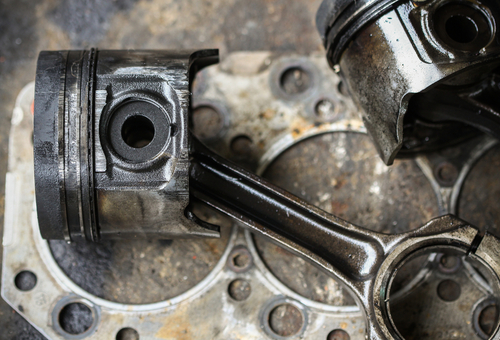
In this, the final instalment in the series of articles on piston failures in modern engines, we discuss two of the most common causes of piston seizures and failures in petrol and diesel engines. These causes are fuel flooding and a lack of cylinder lubrication, and while the underlying causes of these issues are often easy to repair, the damage they cause to pistons and piston rings are often overlooked or ignored until the engine fails –which could happen many months after the original problem had been resolved.
Of course, a catastrophic loss of the engine oil will damage more than the pistons and cylinder walls. In such an event, the crankshaft bearings will usually fail long before damage to the pistons occurs, so it would be reasonable to blame the overall engine failure on a lack of oil.
However, things become somewhat less clear when conditions such as intermittent or infrequent low oil levels damage pistons a little bit at a time. A little scarring or rubbing on the piston skirts or rings may not be fatal the first time it occurs but over time, the cumulative effect of "a little damage at a time" reaches the point where the pistons can fail, seize, or even disintegrate violently.
Sadly, though, we cannot see the non-fatal damage to pistons caused by issues like temporary or transient fuel flooding or infrequent low oil levels, unless we dismantle the affected engine. Unless the engine uses more oil than usual, the pistons rattle in their bores upon cold starts, or we see a measurable drop in engine performance, we are often unaware that the pistons and/or piston rings are damaged at all.
The more experienced among us might suspect that at least some piston damage might have occurred because of less than ideal heat dissipation or lower than required oil levels. However, customers typically resist the idea that we might want to dismantle their engines just to see if one or more pistons might have been damaged by say, leaking fuel injectors or by one or two occurrences of low oil levels.
As a practical matter then, a sudden/catastrophic/ unexpected engine failure might not be so sudden and/or unexpected as the customer believes. In the real world that we as mechanics inhabit, sudden or unexpected engine failures are rare; in fact, the vast majority of engine failures are the results of successive little bits of damage that pistons and other sliding surfaces had sustained over long periods.
Most actual engine failures are, in fact, the culmination of a long process of deterioration caused by conditions such as persistent poor lubrication, excessive heat, poor heat dissipation, or in some cases, engines not running hot enough for long enough to minimise mechanical wear of moving parts, which begs this question-
In the interests of brevity, we will answer this question simply by saying that relatively few mechanics working in general mechanical workshops have ever seen the inside of a worn or damaged but still working engine. Moreover, even fewer mechanics working in general mechanical workshops have had the opportunity to examine the internals of such an engine in fine detail, and fewer still have attempted a diagnosis of the underlying causes of the engine's slow deterioration and ultimate failure.
If you are not an expert rebuilder, you may never see the effects of the issues described below, but it is nevertheless worth knowing what to tell customers who are complaining of a slow deterioration of their engines. Let us start with a discussion of-
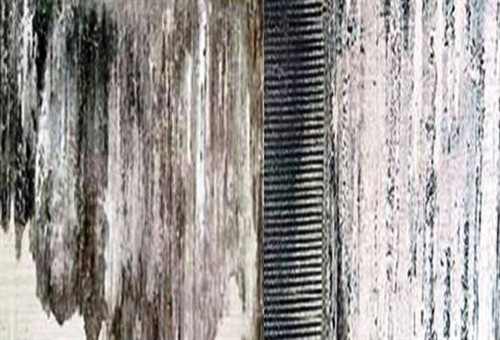
Image source: https://www.memoparts.com/img/cms/Documents/Piston%20Failue.pdf
It is important to understand that poor lubrication and a lack of lubrication are not the same, and either condition affects pistons differently. Consider the image above-
In the comparison of wear marks shown above, the wear marks on the left were caused by the complete elimination of the lubricating oil film between the piston and the cylinder wall. This condition typically creates large, seamless areas of extreme damage on the piston skirt that is often discoloured, as shown here. Note though that in the beginning stages of this process of wear there are typically no matching damaged areas on the opposite side of the piston. Below is an example of a piston damaged by a complete lack of lubrication-
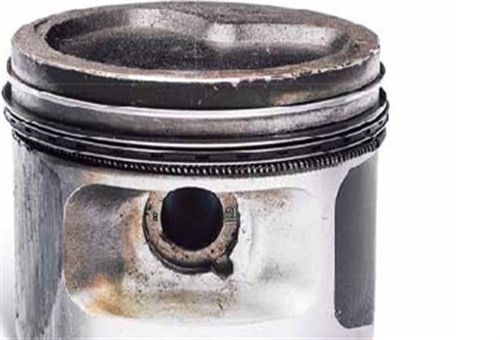
Image source: https://www.memoparts.com/img/cms/Documents/Piston%20Failue.pdf
By way of contrast, the wear marks on the right were caused by a partial breaking down of the oil film, which, when it happens, usually does not affect the entire piston during the first stage of the problem. In practice, the most noticeable difference between a complete lack of lubrication and a partial breakdown of the oil film is that the wear marks caused by a partial breakdown (of the oil film) have a polished, almost metallic surface finish without any discolouration.
NOTE: Note that the lack of wear or seizure marks on one side of the piston shown above excludes a general lack of a piston to cylinder wall clearance as a cause of the damage. If the problem were due to insufficient clearance between the piston and the cylinder wall, the piston would have shown wear/seizure marks on both sides of the skirt.
Below is an example of a piston from a diesel engine showing signs of damage caused by a partial breakdown of the lubricating oil film-
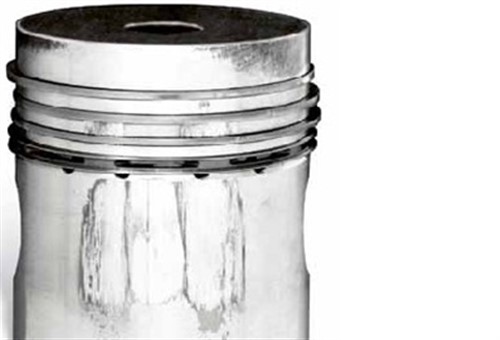
Image source: https://www.memoparts.com/img/cms/Documents/Piston%20Failue.pdf
This example shows the lack of discolouration of the wear marks on the piston skirt. Note that the wear marks extend into the ring zone; while this is common on diesel pistons, it happens less often on petrol pistons because petrol pistons shed the heat caused by poor lubrication more readily than thicker, more massive diesel pistons do.
As a practical matter, partial lubrication always causes excessive wear in the load-bearing parts of the piston/cylinder interface. Put differently, the effects of partial lubrication are worst at the points where a normal wear pattern would have developed on the piston had the lubrication issue not arisen.
Note that in both petrol and diesel engines, poor lubrication of the cylinder wall can progress into a complete lack of lubrication as the pistons' temperature continues to rise due to the increased friction. If the engine is not switched off in time, the increase in temperature can cause the pistons to expand to the point where lubrication oil film is displaced, thus causing severe boundary lubrication conditions which, usually causes pistons to seize in the cylinder bores, which brings us to-
Note that although a complete lack of lubrication and a partial breakdown of lubrication have different effects on pistons, at least in the beginning stages of both problems. However, a partial breakdown of the oil film can progress into a full-blown lack of lubrication if the engine continues to run. Since it is, therefore, not always easy or possible to determine the root cause of the problem, all possible causes of piston/cylinder wall lubrication issues must be investigated and corrected if an engine is to be rebuilt or reconditioned.
In practice, some of the possible causes of piston/cylinder wall lubrication issues could include, but are not limited to the following-
Low or insufficient oil pressure
Since the primary means of lubricating cylinder walls on petrol engines is oil squirting into the underside of the pistons from the connecting rod big ends, low or insufficient oil pressure for whatever reason could result in insufficient quantities of oil being delivered to the cylinder walls.
Note that the most common causes of insufficient oil pressure on newly rebuilt or reconditioned petrol engines include incorrect or excessive main and big-end bearing clearances, excessive camshaft bearing clearances and incorrectly set oil pressure relief valves.
Most diesel engines, on the other hand, are fitted with large-diameter spray nozzles that spray large amounts of oil into the underside of the pistons, from where the oil splashes onto the cylinder walls. Therefore, the lubrication systems of diesel engines circulate oil at much higher flow rates than lubrication systems on petrol engines. The downside is, however, that anything that affects the oil flow rate through a diesel engine has a direct effect on the volume of oil that is dispersed through the spray nozzles. In practice, in most diesel engines, a reduction in the oil flow rate of as low as 6-8 per cent will result in insufficient volumes of oil being delivered to the pistons and cylinder walls.
Poor engine cooling
The most common cause of poor cooling on newly rebuilt engines is either the presence of air bubbles in the circulation pattern or the plugging of some parts of the cooling system, such as heater hoses. Both conditions can potentially disrupt the coolant's circulation pattern, which could, in its turn, cause poor heat dissipation from some parts of the engine.
If the disruption is severe enough, one side of one or more cylinders could heat up to the point where the lubrication oil film on the cylinder walls can evaporate or break down, which is what usually causes only one side of one or more pistons to seize.
Oil dilution/unsuitable oil
Oil dilution is relatively rare on petrol and common rail diesel engines, but it is a common problem on diesel engines with unit injection systems. If the piston rings on such an engine are in a less than perfect condition, leaking injectors cause large quantities of unburned fuel to seep into the crankcase to dilute the engine oil.
Since diesel fuel is a powerful solvent, the presence of high levels of diesel in engine oil severely degrades the lubricity of the oil film on the cylinder walls to the point where effective lubrication of the sliding surfaces becomes impossible.
The same is true for both degraded engine oil, and engine oil of the wrong formulation, type, or viscosity. As a practical matter, the lubrication demands of modern diesel engines are so high that unsuitable or degraded engine oil can destroy the pistons even in a new diesel engine in a matter of minutes- even if there is no dissolved fuel in the oil, which brings us to-
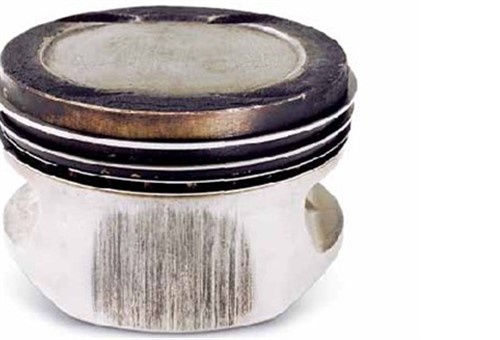
Image source: https://www.memoparts.com/img/cms/Documents/Piston%20Failue.pdf
This example shows the clearly defined linear scratches on the skirt of a piston from a petrol engine that is characteristic of excessive amounts of fuel washing the lubricating oil film from a cylinder wall*. In petrol engines, this type of damage is always present only on parts of the piston skirt that bears on the cylinder wall. i.e., on the parts of the piston skirt on which a normal wear pattern would have developed.
* In the days when engines used carburettors instead of advanced fuel control systems, this was perhaps the most common form of piston damage on petrol engines of all types and designs.
However, it should be noted that this type of damage is exceedingly rare on standard modern petrol engines, regardless of whether the engine is new, reconditioned, or rebuilt. In practice, the amount of fuel required to wash the lubricating oil film off cylinder walls creates such overly rich mixtures in a non-modified petrol engine that a driver will receive ample warning in the form of flashing warning lights long before a piston suffers significant damage.
Nonetheless, this is not the case with non-common rail diesel engines. Consider the example of a diesel piston below-
Image source: https://www.memoparts.com/img/cms/Documents/Piston%20Failue.pdf
In this example taken from a diesel engine with a unit-injection system, the lack of lubrication caused by the removal of the oil film by excessive amounts of fuel caused a part of the piston to seize in the cylinder bore. In this particular example, the repeated micro-welds between the piston and the cylinder wall created sufficient heat not only to tear large chunks out of the piston crown but also to “weld” the rings into the ring grooves.
There are, for the most part, two reasons why diesel pistons suffer more damage than petrol pistons. The first reason is that diesel pistons are more massive than petrol pistons, and as a result, they accumulate more heat than pistons in petrol engines do. The second reason involves how air/diesel fuel mixtures combust- unlike petrol mixtures that start burning at a point around the spark plug electrode before expanding outwards, diesel fuel mixtures ignite simultaneously at multiple points throughout the mixture.
Thus, if liquid diesel fuel is present in the cylinder, the liquid fuel will remove the oil film from the cylinder walls as the piston moves up and down. In cases where the engine only starts after extended periods of cranking, each intake stroke will pump more fuel into the cylinder(s). This means that if the engine is cranked for a sufficiently long period, the increasing amount of liquid fuel in the cylinders can remove the oil film from the cylinder wall's entire circumference. As a practical matter, this means that when the engine does eventually start, it could start without any lubrication on the cylinder wall(s).
Provided that the injectors do not leak, proper lubrication of the cylinder wall(s) will be re-established within a few engine cycles, but despite that, both the piston rings and the cylinder walls(s) will have run dry for a few engine cycles. Over time, each successive extended period of cranking compounds the damage, which eventually results in levels of damage to the piston rings that affect their operation. In short, the more damage the pistons rings suffer, the more damage they inflict on the cylinder walls until the piston rings fail altogether.
However, in cases where one or more fuel injectors leak or atomise fuel poorly, those injectors can spray fuel directly onto a part of the cylinder wall(s). In these cases, the affected part of the cylinder wall is deprived of proper lubrication more or less permanently, and damage to the piston as shown in the above example is almost inevitable.
Note, though, that while damage to pistons caused by fuel flooding is relatively common on diesel engines with unit injection systems, fuel flooding can also occur on common rail diesel engines, albeit only very rarely. Part of the reason why it is a rare occurrence on common rail diesel engines is that the combination of extremely high injection pressures and very small injection orifices produce fuel droplets that are too small to "stick" to the cylinder walls.
One other possible cause of fuel flooding on common rail diesel engines is premature fuel injection timing, but bear in mind that this condition will typically have to be present in conjunction with defective injectors to deposit fuel onto the cylinder walls. Moreover, seriously advanced injection timing will typically produce symptoms like reduced engine power and increased emissions levels, both of which will alert an attentive driver to the fact that something is wrong long before the pistons will suffer fatal or even serious damage, which brings us to the-
While some types of damage to piston rings can increase the effects of fuel flooding, the most common causes of fuel flooding could include one or more of the following-
We hope that you have found the information presented in this series of articles helpful and informative, but the fact is that there is a high likelihood that you will never see the effects that these kinds of problems have on pistons for yourself- unless, of course, you take up engine rebuilding as a specialisation.
Nonetheless, if you have to explain to customers what the most likely causes of high oil consumption rates, a loss of compression, or even some kinds of mechanical noises on their engines are, it helps to remember that sudden, catastrophic piston failures are rare and that most piston failures result from pistons operating under less than ideal conditions for extended periods.
Moreover, it also helps to remember that things like high oil consumption can be the result of problems besides worn piston rings or hardened valve stem seals. In fact, how often have you considered persistent low oil levels as the primary cause of excessive oil consumption?
On the face of it, low oil levels should not cause high oil consumption. However, it sometimes does, but if you are aware of the secret lives of pistons and the conditions they are required to endure, you will find it easier to make the connection between cause and seemingly unlikely effect. As a result of this understanding, it becomes easier to explain the progression of some problems to your customer, which is perhaps the most important thing of all.